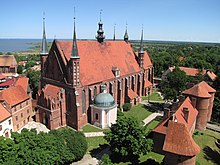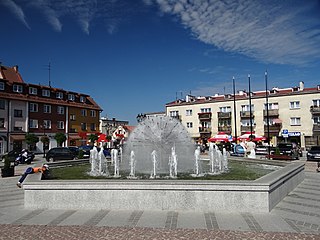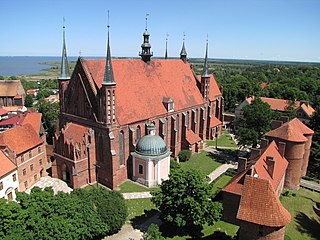| |||
| Warmia-Masuria | |||
| Capital | Olsztyn | ||
|---|---|---|---|
| Residents | 1.437.812 (2016) | ||
| surface | 24,191 km² | ||
| no tourist info on Wikidata: | |||
| location | |||
 | |||

The Warmian-Masurian Voivodeship(Polish: województwo warmińsko-mazurskie) lies in the northeast Poland. The region borders in the north Russia (Kaliningrad Oblast), in the east to the Podlaskie Voivodeship, in the south to the Masovian Voivodeship, in the southwest to the Kuyavian-Pomeranian Voivodeship and in the west to the Pomeranian Voivodeship. Is the capital of the voivodeship Olsztyn. The only other big city is Elbląg. In addition to Warmia and Masuria, there is also Oberland in the voivodeship.
Regions

Masuria
Masuria occupies the eastern part of the Warmian-Masurian Voivodeship. Most of the time, the term Masuria mainly refers to the area of Masurian lakes, so the Allenstein Lake District, Sensburger Lake District, Lycker Lake District and the Great Masurian Lakes, Roger that. In some cases, however, the smaller lake districtsthat join up to the Lithuanian border in the east are also counted as Masuria, although they are already in the Podlaskie Voivodeship lie. Masuria was shaped by thousands of lakes and moraine hills from the Ice Age and is ideal for water sports. Most of the great lakes are connected by rivers and canals, so that canoeists and sailors can practically find hundreds of kilometers of waterways network. The name Masuria goes back to the Polish immigrants from Mazovia, who have been living since the 15th and 16th centuries. Century settled around the Great Masurian Lakes in the "Great Wilderness".
The main region of Masuria is the Masurian Lakes area. With an area of 114 km² is the Spirdingsee (Polish Śniardwy) the largest inland waterway in Poland and a preferred sailing area. The one to the north Mauersee (Polish Mamry) is hardly smaller at 104 km². Many of the islands there are designated as bird sanctuaries. These two large lake complexes are intertwined by rivers, canals and other lakes. All around the lake district there are delightful holiday resorts with good overnight and leisure opportunities. There are good bathing opportunities everywhere. The area is one of the largest holiday regions in Poland.
To the east of the Masurian Lakes, the landscape becomes more hilly and the villages even quieter. The so-called humpback masur is very attractive, but not as popular as the western part of the region. There is less accommodation here, but there are, for example, a large number of farms that are open to visitors. An ideal area for guests who are only looking for nature and tranquility.
At Iława (German German Eylau) is the westernmost lake area of Masuria, the Eylauer Seenplatte. It is also sometimes referred to as the West Masurian Lake District. Countless large and small lakes are connected by canals and rivers and offer excellent water sports. The area around the Geserichsee, (Polish. Jeziorak), is through the Oberland Canal, which overcomes a height difference of approx. 100 meters, with the Weichselhaff and the Baltic Sea connected.
In the southwest the Warmian-Masurian Voivodeship also has a share in the Kulm-Dobrin Lake Districtalready in the historical Kulmer Land lies.
places
Great Masurian Lakes


- 1 Giżycko
 (Soldering)
(Soldering)
- 2 Mikołajki
 (Nikolajken)
(Nikolajken)
- 3 Pisz
 (Johannesburg)
(Johannesburg)
- 4 Ruciane-Nida
 (Rudczanny-Nieden)
(Rudczanny-Nieden)
- 5 Węgorzewo
 (Angerburg)
(Angerburg)
- 6 Wojnowo
 (Eckertsdorf)
(Eckertsdorf)
- 7 Sztynort(Steinort)
- 8 Korsze(Korschen)
- 9 Jeziorany(Seeburg)
- 10 Biskupiec
 (Bishop's castle)
(Bishop's castle)
- 11 Ryn
 (Rhine)
(Rhine)
- 12 Pasym(Passenheim)
- 13 Nidzica
 (Neidenburg)
(Neidenburg)
- 14 Wielbark(Willenberg)
East Masuria

- 15 Ełk
 (Elk)
(Elk)
- 16 Gołdap
 (Goldap)
(Goldap)
- 17 Biała Piska
 (Bialla)
(Bialla)
- 18 Orzysz
 (Arys)
(Arys)
- 19 Olecko
 (Treuburg)
(Treuburg)
Western Masurs


- 20 Grunwald (Tannenberg)
- 21 Iława
 (German Eylau)
(German Eylau)
- 22 Morąg
 (Moors)
(Moors)
- 23 Olsztynek
 (Hohenstein)
(Hohenstein)
- 24 Ostróda
 (Osterode)
(Osterode)
- 25 Starlings Jabłonki (Alt Jablonken)
- 26 Pasłęk

- 27 Młynary

- 28 Miłakowo

- 29 Susz

- 30 Zalewo

- 31 Miłomłyn
- 32 Kisielice
- 34 Lubawa

- 35 Lidzbark

- 36 Działdowo

- 37 Nidzica

Lakes

- 1 Geserichsee
- 2 Daddaisee
- 3 Gehlandsee
- 4 Mauersee
- 5 Löwentinsee
- 6 Spirdingsee
- 7 Lower Lake
- 8 Roschsee
- 9 Laschmieden lake
- 10 Great Sellmentsee
- 11 Raygrodsee
Kayak trails

- Jeglinner Canal
- Oberland Canal
- Masurian Canal
- All
- Rapped
- Drewenz
- Guber
- Krutynia
- Lega
- Elk
- Omulef
- Ossa
- Passarge
- Pisa
- Rosogga
Other goals

- 1 Fuehrer's headquarters in Wolfsschanze
- 2 Baroque monastery Heilige Linde

- 3 Johannisburger Heide
- 4 Rominter Heath
Warmia
Warmia (Polish Warmia) lies between western Masuria and the Great Masurian Lakes. The Warmia region with the capital Allenstein (Polish Olsztyn) is named after the Warmier tribe. It is not only particularly scenic, but also offers a number of places of cultural and historical interest. Although it is in Masuria, it has a completely different historical background. Unlike Masuria, Warmia came directly to Poland as royal Prussia in 1466, while Masuria became a Polish fiefdom as princely Prussia. After Masuria became Protestant in 1525, Warmia remained Catholic and remained with Poland until the first Polish partition in 1772, while Masuria dissolved the feudal union with Poland in 1660.
places



- 38 Olsztyn
 (Allenstein)
(Allenstein)
- 39 Dobre Miasto
 (Guttstatt)
(Guttstatt)
- 40 Kętrzyn
 (Rastenburg)
(Rastenburg)
- 41 Lidzbark Warmiński
 (Heilsberg)
(Heilsberg)
- 42 Mrągowo
 (Sensburg)
(Sensburg)
- 43 Reszel
 (Rössel)
(Rössel)
- 44 Sorkwity (Sorquinces)
- 45 Święta Lipka
 (Holy linden tree)
(Holy linden tree)
- 46 Szczytno
 (Ortelsburg)
(Ortelsburg)
- 47 Elbląg
 (Elblag)
(Elblag)
- 48 Tolkmicko

- 49 Frombork
 (Frauenburg)
(Frauenburg)
- 50 Kadyny (Cadines)
- 51 Braniewo
 (Braunsberg)
(Braunsberg)
- 52 Pieniężno

- 53 Orneta

- 54 Bisztynek

- 55 Jeziorany
- 56 Biskupiec

- 57 Barczewo

- 58 Ostróda

- 60 Bartoszyce

- 61 Sępopol

background
Masuria was settled by the Baltic tribes of the Pruzzen and Galindians in the early Middle Ages. In 1226 the Polish prince Konrad von Mazowien brought the Teutonic Knights from the Holy Land (or Hungary) to the north of Poland (Kulmer Land) in order to Christianize the Pruzzen. In the 14th century they conquered Warmia from Masuria and destroyed the Pruzzen who refused to abandon paganism. After the Thirteen Years' War, Masuria became a Polish fief in 1466 and Polish settlers from Mazovia settled in Masuria and gave it its name. The fiefdom of princely Prussia, as Masuria and Königsberg were called, was surrounded by areas of the Polish-Lithuanian aristocratic republic of the two nations. In terms of cultural wealth, Masuria was multiethnic with Polish, German, Dutch, Lithuanian and Jewish residents, and many cultural monuments of these people have remained here. After the Polish-Swedish war, the fiefdom of princely Prussia was dissolved and Masuria came directly to Brandenburg and later Brandenburg-Prussia. After the partition of Poland in the second half of the 18th century, it was directly connected to Brandenburg via West Prussia. Tourism developed in the 19th century. After the Second World War, Masuria came to Poland. Today it is one of the most popular excursion regions and houseboat areas in Central Europe.
language
Polish is the official language. You can get quite far with English, of course. Some Poles also speak a second foreign language such as German, French or Russian. Polish is not as difficult to learn as you might think at first.
getting there
We recommend arriving by car, bus or train.
road
The road network is thinner than in the west and south of Poland. This is due to the low population density of the region. In the car, as in all of Poland, the light is compulsory all day. The numerous curves should be approached with particular care, as the Polish car travelers drive quite rough by German standards.
The journey is recommended from Danzig, Warsaw, Toruń or Olsztyn. Since there are no motorways in Masuria, the direct highways should be avoided during the week, as all truck traffic from Russia, Lithuania and the Ukraine romps on these roads. The side streets are less busy but in a similar condition. In addition, you can see something of the dreamlike "Masurian avenue".
Rail network
The rail network is also thinner than in the west and south of Poland.
By bus
The bus network is denser than the rail network. To get to the bases of the houseboat rental companies on the Masurian Lake District, there is a bus shuttle from the airport and the main train station in Warsaw.
By plane
The central international airport is the 1 Olsztyn Airport![]() (IATA: SZY) at Szczytno. International airports nearby are also located in Warsaw, Bydgoszcz and Danzig.
(IATA: SZY) at Szczytno. International airports nearby are also located in Warsaw, Bydgoszcz and Danzig.
By boat
You can travel by ship via the Oberland Canal from Elbing to Osterode. There is no connection to the Masurian Lake District. Shipping with the white fleet on various routes on the Masurian Lakes is very popular. The central port is in Giżycko.
mobility
The center of Warmia-Masuria is Olsztyn, from here all important places can be easily reached by car, train or bus. The fares are very low. The petrol is comparatively cheap in Poland in Masuria.
Tourist Attractions
The numerous crusader castles of the Teutonic Order, the Heilige Linde monastery, the Wolfsschanze, where the assassination attempt on Hitler was carried out in 1944, and the Great Masurian Lakes Landscape ParkA vacation by boat and bike is ideal, as it is the best way to explore the wonderful nature around the Masurian Lake District. You can either rent a boat and a good bike or use the services of the "Classic Lady", a hotel ship, where you are transported by bike from one bike tour to another and also accommodated. Corresponding inclusive tours are offered by various organizers.
activities
Another offer besides sailing is the houseboat vacation. There are three international boat rental companies who, in addition to the Polish operators, offer very comfortable houseboats. There are also combined houseboat and bike tours in which the houseboat serves as a means of transport from bike tour to bike tour and the rental bike is carried on the boat. There are also guided bike, paddle and hiking tours.
kitchen
Polish cuisine is mostly rustic. The old Masurian cuisine has been rescued into modern times in individual components and offers a natural fresh food chain. The pure Polish cuisine is balanced and can also be very meat-heavy (Schaschlick). Overall, the kitchen has a touch of Russian, Polish and German.
The main courses, consisting of poultry, fish, meat or game, are served with boiled or baked potatoes, groats or special Polish dumplings and raw, boiled or marinated vegetables. As a dessert you should definitely choose the Polish cake. There are dark, spicy gingerbreads or shortcrust cakes with chocolate all year round (mazurek), Poppy seed roll or curd cake with raisins and nuts.
The oldest Polish dish (Żur), which can be found in the Slavic world, is a soup made from pickled rye flour and dried bread. It is served with sausage and hard-boiled egg halves. The soup made from pickled beetroot also tastes excellent (barszcz), with tiny raviolis with meat or mushroom filling. Beetroot soup tastes great and is very healthy. The tomato soup with rice or noodles is also recommended.
Beer drinkers are by no means neglected. Polish beer has a good reputation. Polish vodka exists in countless (good) varieties. The Żubrówka is the most original. The bottle always contains an aromatic blade of grass from the jungle of Białowieża. Danziger Goldwasser, a spice liqueur, is enriched with 22-carat gold flakes and is now only produced in Germany.
A waffle with fruits of nature (blueberries, strawberries ...) and / or whipped cream is also recommended as a food for the small hunger. Tasty and cheap!
nightlife
There are a large number of quaint pubs and restaurants in Masuria. The nightlife is concentrated in the voivodeship capital, as well Giżycko and Mikołajki.
security
It is actually quite safe, but you should exercise the necessary care against pickpocketing in large crowds, e.g. in large markets or train stations - as everywhere in the world.
Travelers report that the police are said to be very well equipped and prudent and even go on patrols with dogs at night. One felt very safe in the Masurian Lake District.
climate
The climate is a transitional climate from temperate to continental. The summers are generally warm to hot with monthly averages between 16 ° C and 21 ° C and the winters are cold around -5 ° C. Precipitation falls mainly in spring and autumn, although the amount of precipitation is lower than in southern and western Poland.
trips
Warmian-Masurian Voivodeship borders on the following voivodeships: Mazovia, Pomerania, Kuyavian Pomeranian and Podlaskie. Both the "Wild East" of Podlachia, the last primeval forest with bison, bears and wolves as well as the largest swamps in Central Europe, which are protected in four national parks, and the stormy Polish metropolis Warsaw are not far. Further cultural beauties can be found on the lower Vistula e.g. Danzig, Thorn and Marienburg.
literature
See article too Poland.
Web links
- http://www.warmia.mazury.pl - Warmian-Masurian Voivodeship official website





.JPG/320px-Pisz_-_Ratusz_2012_(2).JPG)





.jpg/350px-Jeziorany,_Poland_-_panoramio_(4).jpg)



_ID_647026.jpg/350px-SM_Nidzica_Ratusz_(3)_ID_647026.jpg)


.jpg/347px-Jezioro_Gołdapskie_(1).jpg)






.jpg/350px-SM_Olsztynek_Ratusz_2018_(0).jpg)


_ID_645083.jpg/240px-SM_Pasłęk_Ratusz_(3)_ID_645083.jpg)














.jpg/350px-Jezioro_Śniardwy,_widok_z_Niedźwiedziego_Rogu_(2017).jpg)

















_ID_644686.jpg/350px-SM_Elbląg_Kościół_św_Mikołaja_(3)_ID_644686.jpg)












